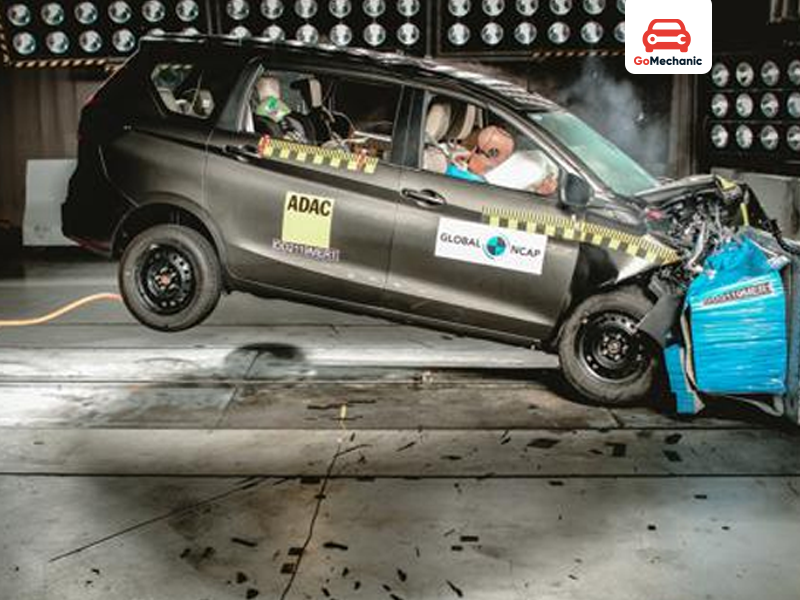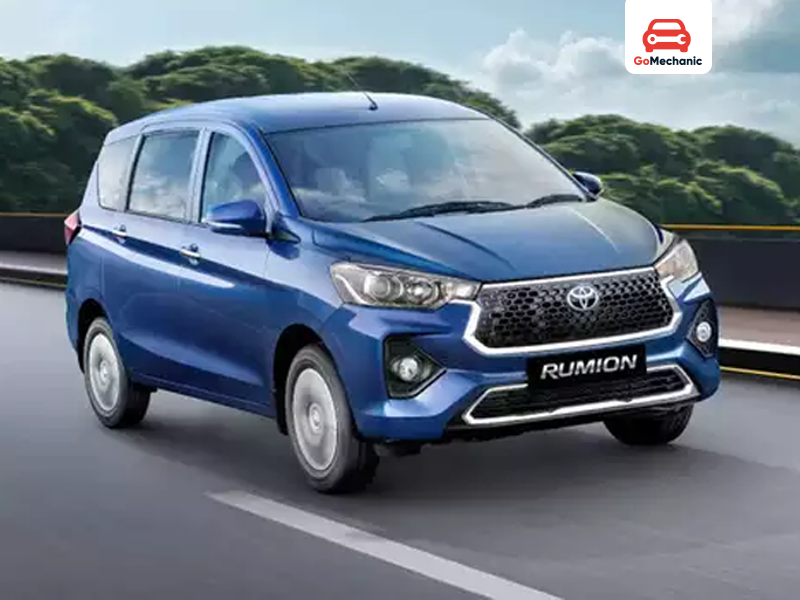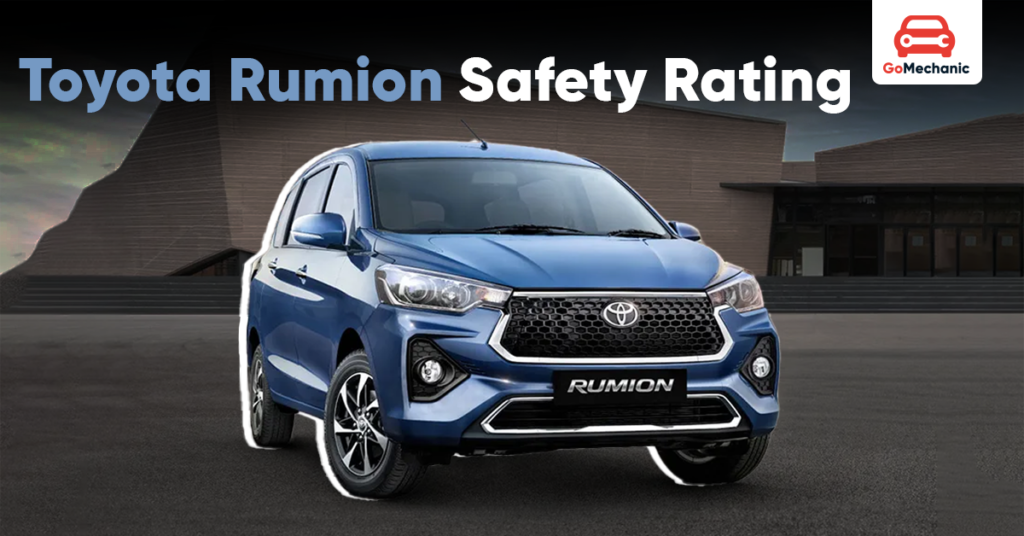When it comes to cars, especially MPVs, safety isn’t optional. It’s the foundation. The Toyota Rumion safety rating is a conversation worth having, especially when families are involved. No one wants a car that looks good in the showroom but fails when it matters most. The rumion safety rating and the tests that come with it matter. The Toyota Rumion is a rebadged version of the Maruti Suzuki Ertiga, and it carries much of the same DNA.
Let’s be clear, the Toyota Rumion is built on a platform that’s been crash-tested before. Its rumion crash test rating gives us an insight into what we’re dealing with. A 3-star rating from Global NCAP for adult occupant protection and a matching 3 stars for child occupant protection. That’s a start. But what does it really mean?
Do read: Renault Triber Safety Rating: How safe is it?
Global NCAP Crash Test: Toyota Rumion’s Safety on the Table

Numbers don’t lie. When we talk about the rumion crash test rating, we’re talking about the real story behind the metal.
- Global NCAP Rating (Adult Occupant Protection): 3 stars
- Global NCAP Rating (Child Occupant Protection): 3 stars
- Crash Test Speed: 64 km/h frontal impact
- Body Shell Integrity: Unstable during higher-impact crashes
For a vehicle in this segment, a 3-star safety rating is somewhat typical. The Toyota Rumion can hold its own in low to moderate-speed crashes, and that’s where it shines. It’s not going to fall apart in a minor collision, but it’s not built to withstand a severe crash either. The structure remains stable under everyday impacts, but anything more intense, and it’s a different story.
So what does this mean in practical terms? For daily commutes, city driving, and short trips, the Toyota Rumion will do its job. It’ll keep you and your passengers safe in the usual driving conditions. But, if you’re looking for an MPV that can handle more extreme scenarios, you might want to keep looking. The rumion safety rating shows it’s adequate for the basics, but not much beyond that.
How Safe Is the Toyota Rumion in Real-World Conditions?

Crash tests, they tell a story. But the real test is out there. On the roads. At 8 AM, during a traffic jam, or when the rain makes the road feel like an obstacle course. How does the Toyota Rumion hold up when you’re not in a crash lab, when you’re just trying to get home in one piece?
So here’s the deal. The rumion safety rating might say one thing, but it’s the driving experience that tells the tale. You can look at all the stats you want. Numbers don’t always tell the full story. But sometimes, it’s enough to see how the car reacts under pressure.
What Works:
The Toyota Rumion has solid fundamentals. It doesn’t scream “super car,” but it doesn’t crumble either. When it comes to frontal impact protection, the structure holds up pretty well. Both the driver and the passenger are protected, though it’s not the sort of protection you’d expect from a car that’s gunning for five stars. But at 3 stars, it’s not bad either.
Dual airbags? Standard across all variants. For a budget MPV, that’s crucial. In case of a frontal crash, you’re covered.
Then, there’s the ISOFIX child seat mounts. It’s a small thing, but it matters. Parents who are aware of child safety appreciate this.
What Doesn’t Work:
Now, don’t get too comfortable. The body shell integrity leaves a lot to be desired. It’s classified as “unstable” in high-impact collisions. That means, in a major crash, things could get dicey. You’re not going to get that “tank-like” feeling with the Toyota Rumion. The structure isn’t as reinforced as you’d want for a car carrying families.
Side impact protection is also a weak spot. There are no side airbags on the lower variants. In case of a side impact, rear passengers are exposed, and that’s not ideal.
Lastly, no advanced safety tech. While rivals like the Kia Carens or Mahindra Marazzo offer ADAS (Advanced Driver Assistance Systems), the Toyota Rumion doesn’t. You won’t find lane-keeping assist, adaptive cruise control, or emergency braking on this car, even though they’re standard in newer models from other brands. So, in the tech race, Toyota Rumion falls behind.
Bottom Line:
For everyday driving in a city, the Toyota Rumion will do. It’s stable. It’ll hold up in a minor fender bender. But it’s far from the safest option out there. It’s a solid contender, but the competition is better equipped for more extreme scenarios.
Tata Tiago Safety Rating: Breaking It Down
A car doesn’t make a statement just by driving well or looking sharp. Not when it’s the one thing between you and chaos. So, how does the Toyota Rumion stack up when it comes to safety? How safe is your family when you’re behind the wheel, cruising down the highway or stuck in city traffic?
Let’s stop pretending. Numbers don’t lie. The Toyota Rumion safety rating sits at 3 stars. The rumion safety rating has yet to see a fresh round of crash tests on its own, but it shares everything with the Maruti Ertiga—the platform, the structure, and much more. That means the Rumion likely mirrors the same performance, unless there’s a hidden design tweak.
You get what you pay for, though. A 3-star safety rating isn’t bad, but it’s certainly not top-tier. If you’re someone who needs something more rugged, a stronger frame, and a bit of finesse in how the car takes an impact, it’s worth checking the numbers behind that 3-star rating. The Ertiga’s crash test showed some critical details we can’t ignore.
Breaking Down the Crash Test: What’s Really Happening?
So, we’ve established the Rumion’s 3-star safety rating. Let’s dig a little deeper. What does this rating really mean when you’re sitting behind the wheel, pressing down the gas?
The Global NCAP test, which is where these numbers come from, doesn’t mess around. At 64 km/h, they test the car’s ability to absorb impact, keep you safe, and maintain structural integrity. The Toyota Rumion crash test rating tells us this:
- Adult Occupant Protection: 3 stars. Moderate protection during frontal crashes. The driver and passenger both get a decent level of protection for head and chest. But don’t expect miracles. It’s good, but not great.
- Child Occupant Protection: 3 stars. Not stellar, but not terrible either. There are ISOFIX mounts to keep child seats safe, but there’s always room for improvement in terms of child safety. It’s adequate, but not groundbreaking.
- Body Shell Integrity: This is where the rubber hits the road—or rather, where the steel meets the crash test barrier. The body’s unstable under high-impact scenarios. That means while it’s okay in smaller accidents, anything bigger could see the frame buckle under pressure.
The Toyota Rumion safety rating points to a car that’s capable of withstanding moderate collisions, but it isn’t built to survive a full-force crash. It’s not the worst out there, but if you’re after something that’s indestructible, you might need to keep looking.
Real-Life Safety: What Happens When You’re Not in a Test Lab?
Numbers on paper are one thing. Real-world driving? That’s a whole different story. The Toyota Rumion isn’t designed for the high-speed, adrenaline-pumping adventures of the highway, but what does it feel like in day-to-day use?
Here’s what you’re dealing with:
- Braking: It’s good, not great. In city traffic, you’re covered. It’s responsive. It’ll stop the car when you need it to. But hit the highway, and you’ll feel the difference. It’s not as crisp or immediate as some of its competitors.
- Impact Resistance: You’ll be fine in lower to moderate-speed crashes, thanks to its relatively strong body, but if you’re expecting it to hold up in a more intense situation, that 3-star safety rating might start to show its limits.
- Visibility & Blind Spots: You’ve got clear enough visibility in front, but rearward visibility is a bit of a gamble. High-profile trucks and buses can sneak up on you when you’re trying to reverse or change lanes.
It’s a practical car for city roads—easy to maneuver, easy to park, and decent on the brakes. But, when you stretch it out onto the highways or out on an open road, the Toyota Rumion safety rating gives you a fair warning. It’s stable, but it’s not built for high speeds or rough impacts.
Competitors and Their Edge
Now, let’s stop sugar-coating it. The Toyota Rumion safety rating has its strengths, but let’s see how it measures up against the competition. Here’s the thing—there are MPVs in the same price range that offer more in terms of safety features and crash resilience.
| Car Model | NCAP Rating | Airbags | ESC + ABS | Body Integrity |
| Toyota Rumion | ⭐⭐⭐ (3 stars) | 2-6 | Yes | Unstable |
| Kia Carens | ⭐⭐⭐⭐ (4 stars) | 6 | Yes | Stable |
| Mahindra Marazzo | ⭐⭐⭐⭐ (4 stars) | 2 | Yes | Stable |
Look at the Kia Carens and Mahindra Marazzo. Both pack 4 stars for safety, with stronger body structures and more airbags. They’ve got the extra edge in terms of durability. The Toyota Rumion isn’t bad, but its body shell and crash resistance can’t match these two.
It’s a competitive market, and Rumion sits in the middle. It’s safe for day-to-day drives and commutes. But if you’re looking for something that feels rock-solid in extreme scenarios, well, maybe look elsewhere.
Toyota Rumion Safety Features: What’s Inside?
We’ve talked about the ratings. Now, let’s talk about what you actually get when you’re behind the wheel. Safety features, at the end of the day, make the biggest difference when you’re out on the road.
For starters, you get dual airbags—one for the driver and one for the passenger. You get ABS with EBD, which makes sure you’re not skidding in emergencies. There’s also electronic stability control (ESC), which helps you maintain control when you’re taking sharp turns or driving on slippery surfaces. Pretty standard. But here’s where it falls short: No ADAS. No lane-keeping assist. No collision mitigation. While competitors like the Kia Carens and Mahindra Marazzo are packing all these advanced safety features, the Toyota Rumion sticks to the basics.
Should You Buy the Toyota Rumion?
In a nutshell, yes. But, with a few caveats. The Toyota Rumion safety rating is solid for city driving, but if you want a car that’s going to stand strong in every situation, you might want to dig deeper into the safety stats of its rivals. It’s a great car for regular family use. Fuel-efficient, affordable, and with Toyota reliability that you know and trust.
However, if you’re someone who cares more about advanced safety tech or high-speed crash resilience, the Rumion might not cut it. If you don’t mind compromising on the premium safety features and prefer a well-priced family car, then it’s the right choice.
Final Words: The Toyota Rumion Verdict
So, how do we wrap this up? The Toyota Rumion safety rating is good, not great. It’s safe enough for daily commutes and family trips, but it doesn’t compare to the high-tier MPVs in its segment when it comes to build and tech.
Is it a solid choice? Yes. But is it the safest? That’s for you to decide. What matters most—peace of mind or bang-for-buck safety?
Also read: Mahindra XEV 9e scored a 5-star safety rating from Bharat NCAP
FAQs
- What is the Toyota Rumion safety rating?
It holds a 3-star Global NCAP rating, shared with the Maruti Ertiga. - Does the Toyota Rumion have side airbags?
Yes. Higher variants come with side and curtain airbags for added protection. - How does Toyota Rumion compare to the Kia Carens in safety?
The Kia Carens holds a 4-star NCAP rating, which is better than the Rumion. It has a stronger body shell and more safety features. - Is Toyota Rumion safe for long trips?
It is safe for regular city drives, but for long highway trips, the Toyota Rumion safety rating is average. It’s stable but not built for extreme scenarios.
Helpful read: Skoda Slavia Safety Rating by Global NCAP & Features

